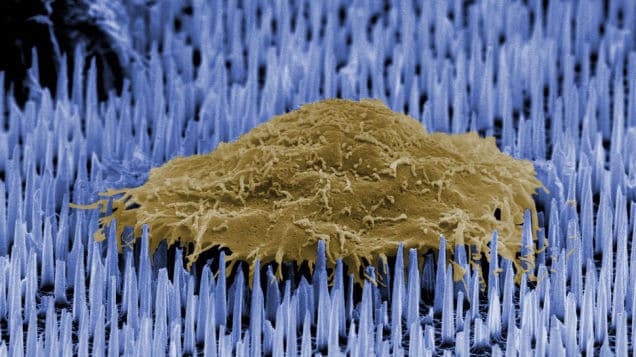The technology, developed by researchers from Imperial College London and Houston Methodist Research Institute in the US was recently trialed successfully on mice, where it was used to prompt parts of the body to generate new blood vessels.

The nanoneedles work by delivering nucleic acids to a specific area. Nucleic acids are the building blocks of all living organisms and they encode, transmit and express genetic information. Scientists are currently investigating ways of using nucleic acids to re-program cells to carry out different functions.
The nanoneedles are tiny porous structures that act as a sponge to load significantly more nucleic acids than solid structures.
This makes them more effective at delivering their payload. They can penetrate the cell, bypassing its outer membrane, to deliver nucleic acids without harming or killing the cell.
The devices are made from biodegradable silicon, so they can be left in the body without leaving a toxic residue behind.
In a trial described in Nature Materials, the team showed they could deliver the nucleic acids DNA and siRNA into human cells in the lab, using the nanoneedles. They also showed they could deliver nucleic acids into the back muscles in mice. After seven days there was a six-fold increase in the formation of new blood vessels in the mouse back muscles, and blood vessels continued to form over a 14 day period. The technique did not cause inflammation or other harmful side effects.
The hope is that one day scientists will be able to help promote the generation of new blood vessels in people, using nanoneedles, to provide transplanted organs or future artificial organ implants with the necessary connections to the rest of the body, so that they can function properly with a minimal chance of being rejected.
Commenting on the research, Prof Molly Stevens from the Departments of Materials and of Bioengineering at Imperial College said: “There are a number of hurdles to overcome and we haven’t yet trialed the nanoneedles in humans, but we think they have enormous potential for helping the body to repair itself.”
The researchers are now aiming to develop a material like a flexible bandage that can incorporate the nanoneedles. The idea is that this would be applied to different parts of the body, internally or externally, to deliver the nucleic acids necessary to repair and reset the cell programming.











McMurtry Spéirling defies gravity using fan downforce
Ground effect fans were banned from competitive motorsport from the end of the 1978 season following the introduction of Gordon Murray's Brabham...